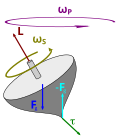Torque


In physics, torque is the tendency of a force to turn or twist. If a force is used to begin to spin an object, or to stop an object from spinning, a torque is made.
The force applied to a lever, multiplied by the distance from the lever's fulcrum, multiplied again by the sine of the angle created, is described as torque. This is also known as "r cross f," or "force times fulcrum distance times sine theta."
Fulcrum
Fulcrum is the axis of rotation or point of support on which a lever turns in raising or moving something.
Equation
The equation for torque is:
- [math]\displaystyle{ \boldsymbol \tau = \mathbf{r}\times \mathbf{F}\,\! }[/math]
where F is the net force vector and r is the vector from the axis of rotation to the point where the force is acting. The Greek letter Tau is used to represent torque.
The units of torque are force multiplied by distance.[1] The SI unit of torque is the newton-metre. The most common English unit is the foot-pound.
Torque with Angled Forces
When the force is applied at an angle, only the part of the force that aligns with the sine theta component of "r cross f" contributes to torque.
The closer the angle is to 90 degrees, the larger the sine theta value, and the greater the torque generated.
Torque In Gears
Angled force affects how much torque actually gets into a gear system. If less torque is created at the start (because the force isn’t at 90 degrees), then the gear has less to work with.
Angled forces reduce gear efficiency because not all of the force goes into turning the gear.
Torque Media
The torque caused by the two opposing forces Fg and −Fg causes a change in the angular momentum L in the direction of that torque. This causes the top to precess.
Torque curve of a motorcycle ("BMW K 1200 R 2005"). The horizontal axis shows the rotational speed (in rpm) that the crankshaft is turning, and the vertical axis is the torque (in newton-metres) that the engine is capable of providing at that speed.
References
- ↑ Holzner, Steven (2010). Physics Essentials For Dummies. Wiley Publishing. p. 122. ISBN 978-0-470-61841-7.
Other websites
- "Horsepower and Torque" Archived 2007-03-28 at the Wayback Machine An article showing how power, torque, and gearing affect a vehicle's performance.
- a discussion of torque and angular momentum in an online textbook Archived 2010-12-14 at the Wayback Machine
- Torque and Angular Momentum in Circular Motion [dead link] on Project PHYSNET.
- An interactive simulation of torque
- Khan Academy – “Torque and Angular Acceleration”. A video-based explanation of torque, moment arms, and their relationship to angular motion. https://www.khanacademy.org/science/physics/torque-angular-momentum/torque-tutorial/v/torque
- "Gear Force Analysis – Spur and Helical Gears". Drivetrain Hub (2020). An online notebook breaking down how an angled (normal) force on gear teeth splits into tangential, radial, and axial components, and how only the tangential force contributes to torque. https://drivetrainhub.com/notebooks/gears/strength/Chapter%201%20-%20Force%20Analysis.html



